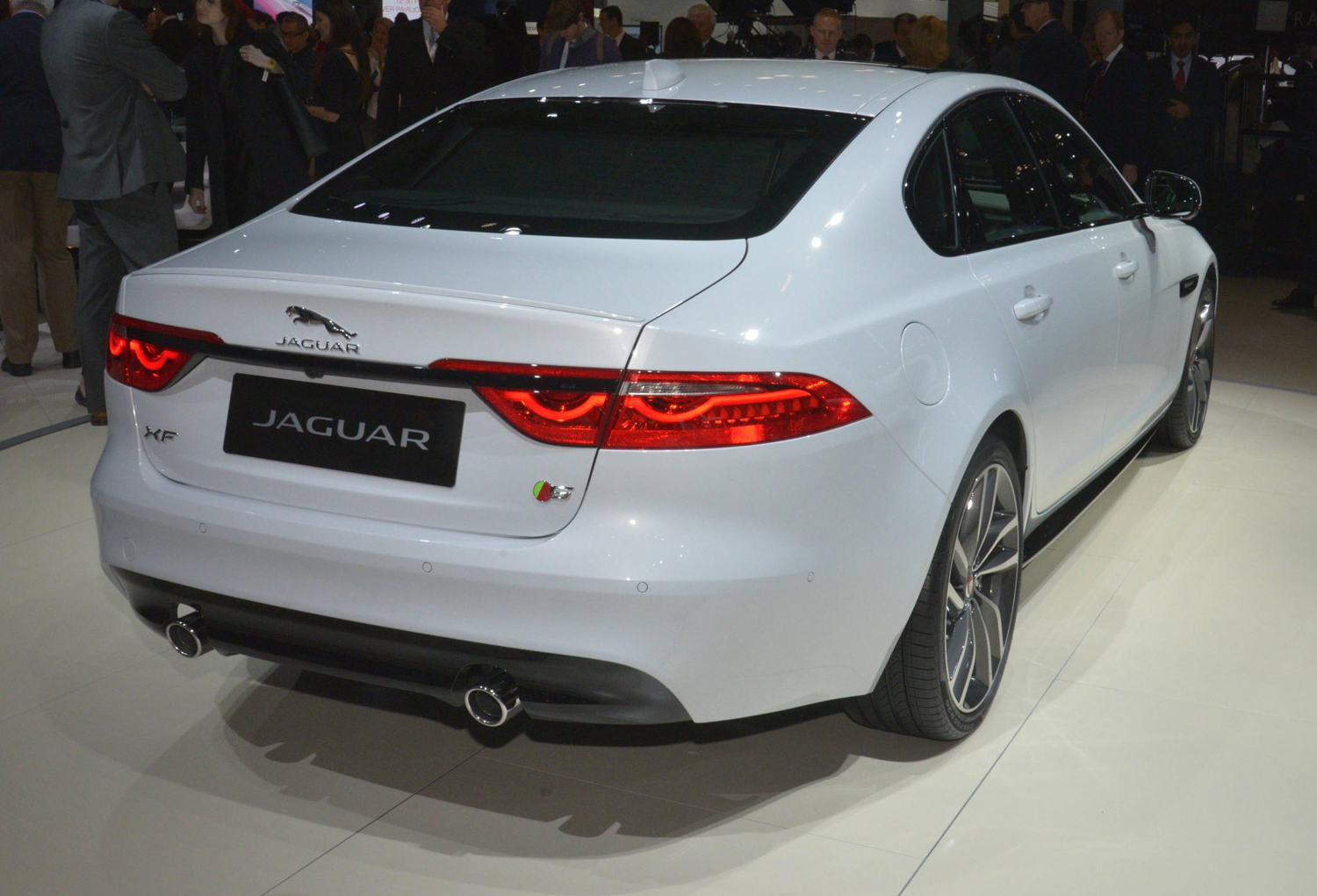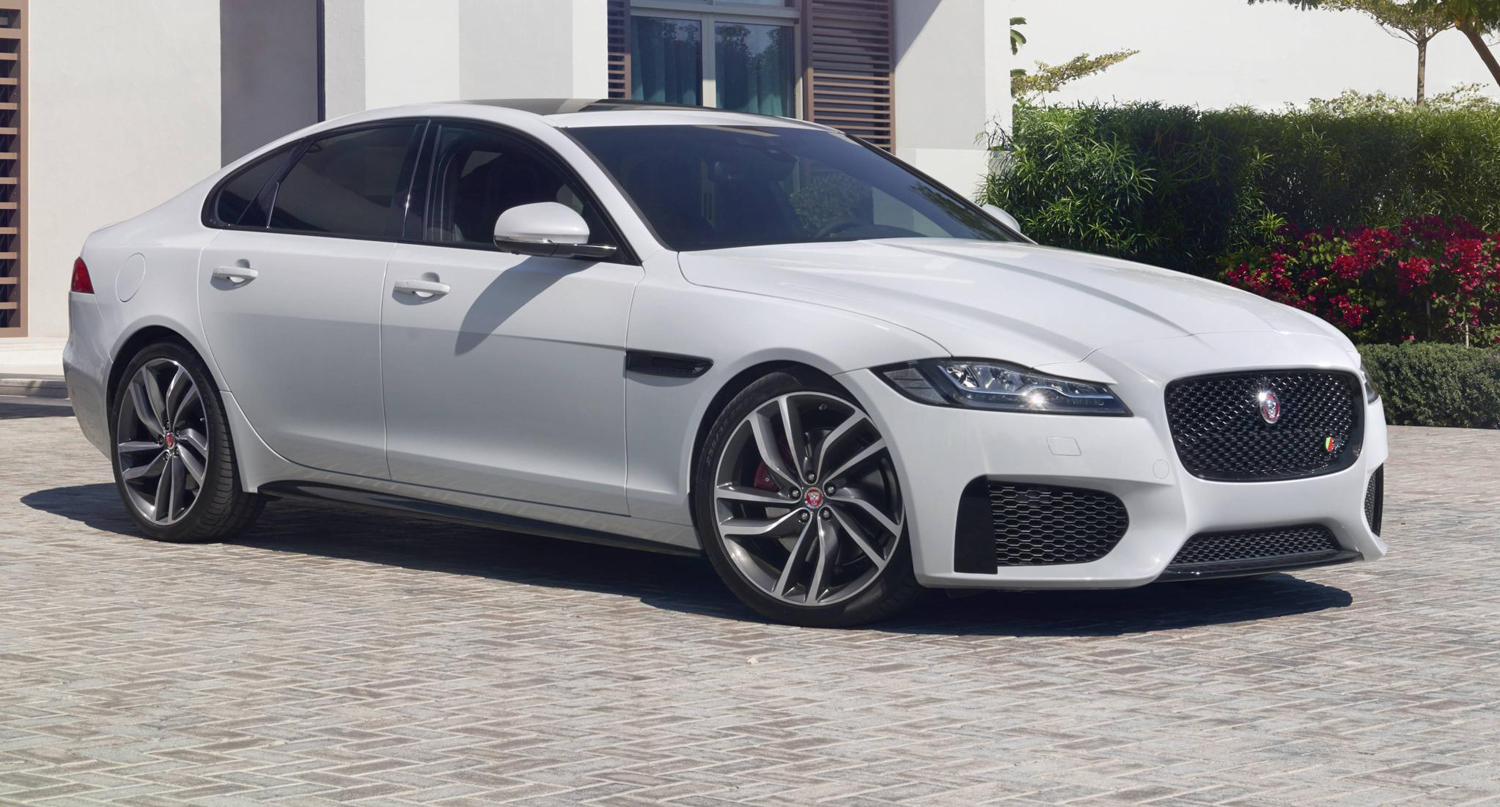
- Second generation Jaguar XF large luxury sedan to deliver lighter weight, coupe-like profile, more interior space and new Jaguar InControl® Touch Pro™ infotainment system1
- The XF features Jaguar aluminum-intensive architecture contributing to a weight savings of 132lbs (RWD) to 265lbs (AWD) compared to outgoing model
- All-new InControl Touch Pro infotainment system with 10.2-inch touchscreen1 available with optional reconfigurable 12.3-inch TFT instrument cluster
- Launching in U.S. with choice of 340hp or 380hp supercharged V6 powertrains mated to 8-speed automatic transmissions
- Front Double-wishbone and Rear Integral Link suspension deliver exceptional ride comfort, handling and refinement
- JaguarDrive Control™ (JDC) system offers drivers choice of three standard driving modes: Normal, Winter and Dynamic2
- All-wheel drive (AWD) utilizes Intelligent Driveline Dynamics system to mate Torque Vectoring by Braking and Dynamic Stability Control to deliver torque on demand and an optimum balance of performance and all-weather capability2
- Optional Adaptive Dynamics system2 utilizes adaptive dampers to further enhance low-speed ride comfort as well as improving handling and agility at higher speeds3
- On AWD models equipped with optional Adaptive Dynamics, the JDC system features unique Adaptive Surface Response mode (AdSR), which distinguishes between different types of surfaces for additional traction2
- Standard All-Surface Progress Control (RWD/AWD) is designed to enable smooth drive-away on low-friction surfaces such as snow and ice – all the driver has to do is steer
- The all-new XF offers a host of additional technology including full-LED headlights, Laser Heads-Up Display, Autonomous Emergency Braking, Adaptive Cruise Control with Queue-Assist, Lane Keeping Assist, Intelligent Speed Limiter and Semi-Automated Parking2
- Pricing will be announced closer to Winter 2015 on-sale date
(MAHWAH, NJ) – March 31, 2015 – The all-new second generation 2016 Jaguar XF large luxury sedan featuring Jaguar aluminum-intensive construction will bring a unique blend of design, technology, and refinement to the segment.
With the launch of the 2016 XF sedan in Winter 2015, all current Jaguar models will now feature lightweight aluminum construction, as will future models such as the Jaguar XE sports sedan and Jaguar F-PACE performance crossover.
The large luxury class sedan will be offered in rear-wheel or all-wheel drive, with a choice between two V6 supercharged engines and the brand’s most comprehensive suite of advanced performance, driver assistance and infotainment technology.
DESIGN
Redesigned from the ground up using Jaguar aluminum-intensive architecture, the second generation Jaguar XF delivers better proportions, more interior space and a progressive, highly streamlined form.
Taking its rightful place between the mid-size Jaguar XE and the full-size luxury Jaguar XJ sedans, the all-new Jaguar XF features a more vertical front end, shorter front overhang, longer wheelbase and new rear quarter windows. Mirroring the evolution of the Jaguar design language, the sleek, coupe-like profile, long hood with deep power bulge and the short front overhang make the XF stand apart from the crowd.
“In creating the all-new XF, as a design team we have been driven by discipline, the discipline of simplicity. Every exterior line on the XF has a clear purpose – nothing is superfluous. Achieving that simplicity takes time and requires great determination; it’s all too easy to add lines to a car, but much harder to add character by leaving lines out. Inside too, we have been driven by the desire to ensure the cabin of the all-new XF is as comforting as it is comfortable. New technology is combined carefully with materials that cosset and reassure. The all-new XF has a clear sense of calm and strength, both outside and inside – and I’m proud of my team for delivering that” said, Ian Callum, Director of Design, Jaguar
Benefiting from the design flexibility of the Jaguar modular vehicle architecture, the wheelbase of all-new XF has been increased by 2in (51mm) to 116.5in (2,960mm) while the overall length of the vehicle decreases by 0.3in (7mm) to 195in (4,954mm) long. This longer wheelbase delivers superior packaging that liberates an additional 0.6in (15mm) of rear legroom, 0.9in (24mm) of rear knee room and up to 1.1in (27mm) of rear headroom.
The front overhang is now 2.6in (66mm) shorter, emphasizing the car’s dynamic, rear-wheel drive stance and the outstanding proportions characteristic to all Jaguar vehicles.
The mesh grille is more vertical than before, helping to reduce drag and delivering a more mature look to the vehicle.
Aerodynamics are improved by using vents in the front bumper to channel air over the front wheels. This helps to prevent the turbulent wheel wake from disturbing the smooth laminar airflow passing around the car.
The headlights, including the optional adaptive full-LED technology, are flush with the surrounding panels, improving aesthetics and aerodynamics. They also feature the signature Jaguar J-Blade LED daytime running lights and a ‘modern quad’ design, referencing the four round lights that Jaguar sedans have made iconic. The fluting running backwards from the top of the headlights is another detail inspired by the rich heritage of the Jaguar brand.
The one-piece aluminum body side pressings emphasize the Jaguar brand philosophy that surfacing should always be executed with the discipline of simplicity and purity. Designing and manufacturing these panels from a single sheet contributes not only to the overall stiffness of the body, but also to surfacing purity and quality as there are no visible joints.
The sweeping, coupe-like profile which defined the first-generation XF has evolved, and now features rear quarter windows. The additional feature allows for a clearer view out from the rear seats, and combined with the standard sunroof, allow more natural light to flood into the cabin highlighting the additional 0.6in (15mm) of legroom and 0.9in (24mm) of knee room delivered by the vehicle.
Still relatively high to emphasize dynamics and movement through ideal proportion between the wheel, body and cabin, the waistline is now slightly more horizontal than before. The roofline is lower and the rear deck longer and higher to reduce drag.
Running from front to back, peaking above the rear wheel in terms of height and then tapering away, is a chamfered feature line known as ‘the spear of light.’ The reflections make the car appear more lithe, agile and elegant.
At the rear, the LED tail lights feature the signature Jaguar design from the F-TYPE – a line intersecting a roundel – also used on the Jaguar XE. Here, the design is repeated, creating a clear hierarchy from the Jaguar XE, and an unmistakable pattern at night.
The chrome signature blade running across the trunk lid between the light clusters is slimmer than before, highlighting the taut surfaces and dynamic visual balance of the all-new Jaguar XF.
To deliver the flush fit of the light clusters and perfect integration of the chrome blade, the trunk lid is made from two steel pressings joined by laser brazing. As well as being energy-efficient, this process was selected for its precision and neat, clean finish.
The interior of the XF has always attracted praise, especially the start-up sequence bringing the car to life as the rotary gear selector rises up from the center console and the air vents rotate into position. The goal was to retain that sense of occasion – and the strong, simple lines and horizontal feel of the instrument panel – but mature the design language and the use of materials, befitting the status of the all-new XF now that the Jaguar XE is in position as the entry-level Jaguar sports sedan.
The layered instrument panel, now with the Jaguar signature ‘Riva Hoop’ inspired by the Jaguar XJ, continues into the door, creating a unique cabin feel. This is enhanced by the generous application of veneers such as Gloss Figured Ebony and textured aluminum trim such as Dark Hex.
With options such as the reconfigurable, 12.3-inch full-TFT instrument cluster and 10.2-inch touchscreen, four-zone climate control, 10-color ambient lighting, Black Suedecloth headliner and fluted Windsor leather seats, the all-new Jaguar XF reflects the standard for interior luxury and design.
The longer wheelbase means the second row sits further away from the rear wheels, improving refinement. This created the opportunity to reduce seat height slightly, contributing to the increased headroom, which gains an additional 1.1in (27mm). Options such as the four-zone climate control system, heated seats and window blinds make the second row more comfortable.
The rear bench also features a 40:20:40 split, making it easier to through-load bulky items such as skis or snowboards. The trunk now features an optional power close function.
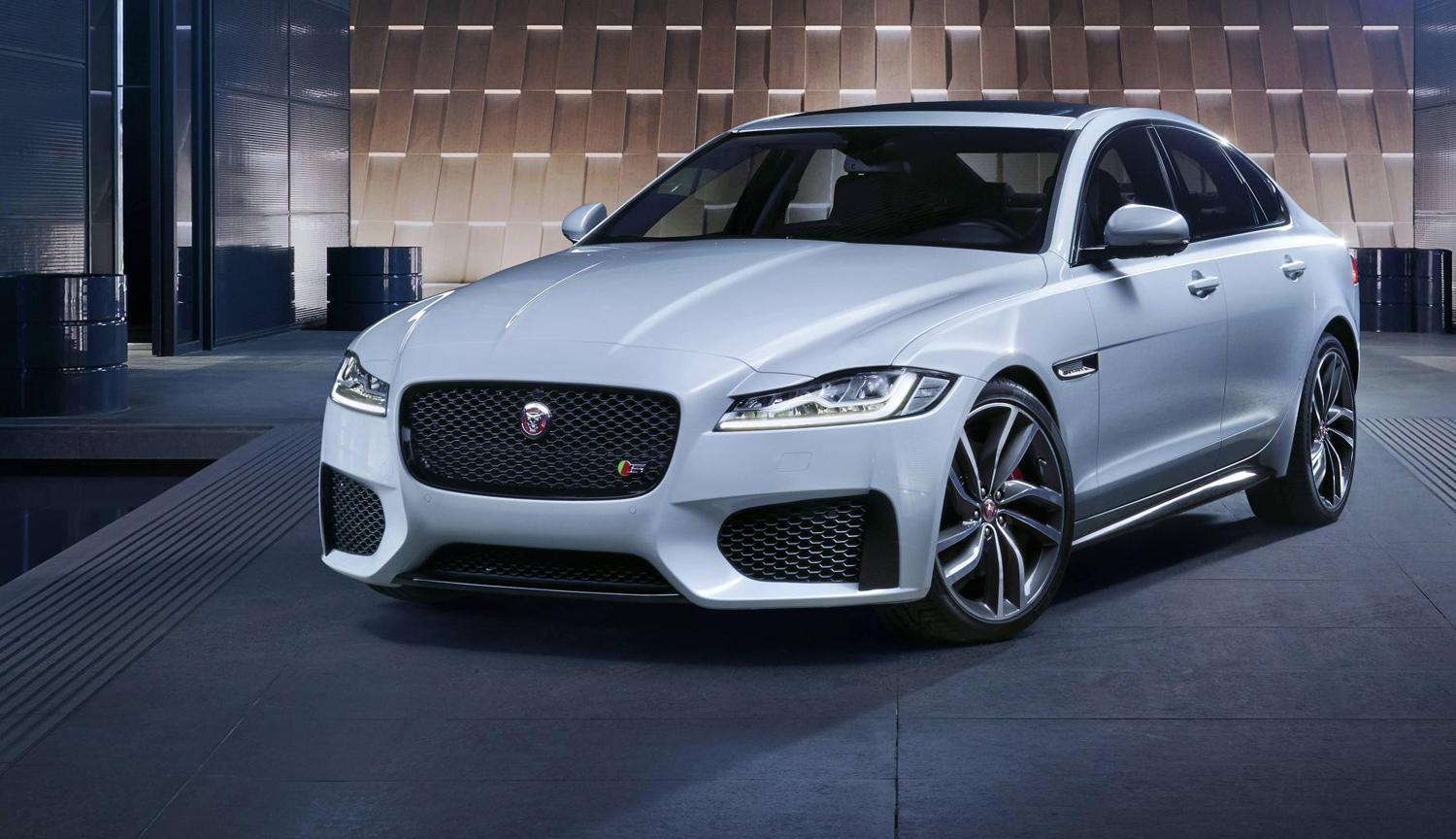
ARCHITECTURE AND BODY STRUCTURE
Aluminum-intensive construction
Used to create inherently light and stiff body structures, aluminum alloys, self-piercing rivets and structural adhesives enhance performance, efficiency, and dynamics. These attributes were engineered into the Jaguar aluminum-intensive architecture from which the all-new Jaguar XF was developed. Also featuring advanced high-strength steels, the aluminum-intensive unibody uses materials intelligently, exploiting each to its full potential.
Aluminum is also used to make the hood and front fenders, while the front-end carrier and cross-car beam are cast from even lighter magnesium alloys. Combined with the other weight savings made throughout the vehicle, the all-new Jaguar XF is up to 265lbs (AWD) lighter than its predecessor.
Features such as the high-pressure die-cast aluminum front suspension towers increase local stiffness and make a significant contribution to the ride, handling and steering of the all-new XF.
The move from an all-steel to an aluminum-intensive unibody leverages more than a decade’s experience of manufacturing luxury vehicles from aluminum in high volume. The one-piece body sides of the all-new XF are testament to expertise in working with the material. Pressed from a single sheet of high-strength 6000-series alloy, the body sides weigh less than 13.2lbs (6kg). Perfecting the deep haunches and the quarter windows incorporated all of the learning from the Jaguar F-TYPE in terms of depth of draw and tightness of radii.
Assembly to the rest of the structure uses a two-stage framing process. The technique allows for greater joint efficiency through optimized positioning of the rivets. This translates to increased torsional rigidity of the body, making the all-new Jaguar XF up to 28 percent stiffer than its predecessor.
The all-new Jaguar XF is more refined with much of the improvement coming from reducing structure-born noise. Critical to this is that the body behaves as one homogeneous structure: wherever vibration energy finds a discontinuity it will concentrate and then radiate noise through to the cabin.
Every part of the body was analyzed in this way to ensure that as many potential sources of noise could be designed-out. In some areas, such as the crash structure behind the front bulkhead, fully-sealed, double-wall structures are used. Where sound deadening has been applied, the latest spray-on materials are used due to their combination of higher performance and lower weight.
Foam baffles inside the aluminum sections also contribute. These pieces are fitted during assembly: as the body passes through the e-coating ovens the heat causes the foam to expand so that it completely fills the section.
A further example of the attention to detail which delivered the vehicle’s low levels of cabin noise is typified by the way in which the high-level brake light is fitted to the body. Running all the way along the full length of the rear glass, this full-LED light has a seal and an acoustic barrier behind it to minimize any noise leakage through to the interior.
5000-series aluminum alloy pressings are used where stiffness is a key, such as in the underframe reinforcements. These include RC5754, a grade unique to Jaguar Land Rover, which is made predominantly from recycled material. Around half of this is scrap sourced from the press shops, helping not only the move towards closed-loop recycling but also reductions in overall electricity consumption and therefore lifecycle CO2 emissions.
As part of the intelligent material mix in the body, the rear longitudinal members and the B-pillar reinforcements are made from ultra-high strength hot-formed boron steels, providing exceptional rigidity and stability of the occupant safety cell.
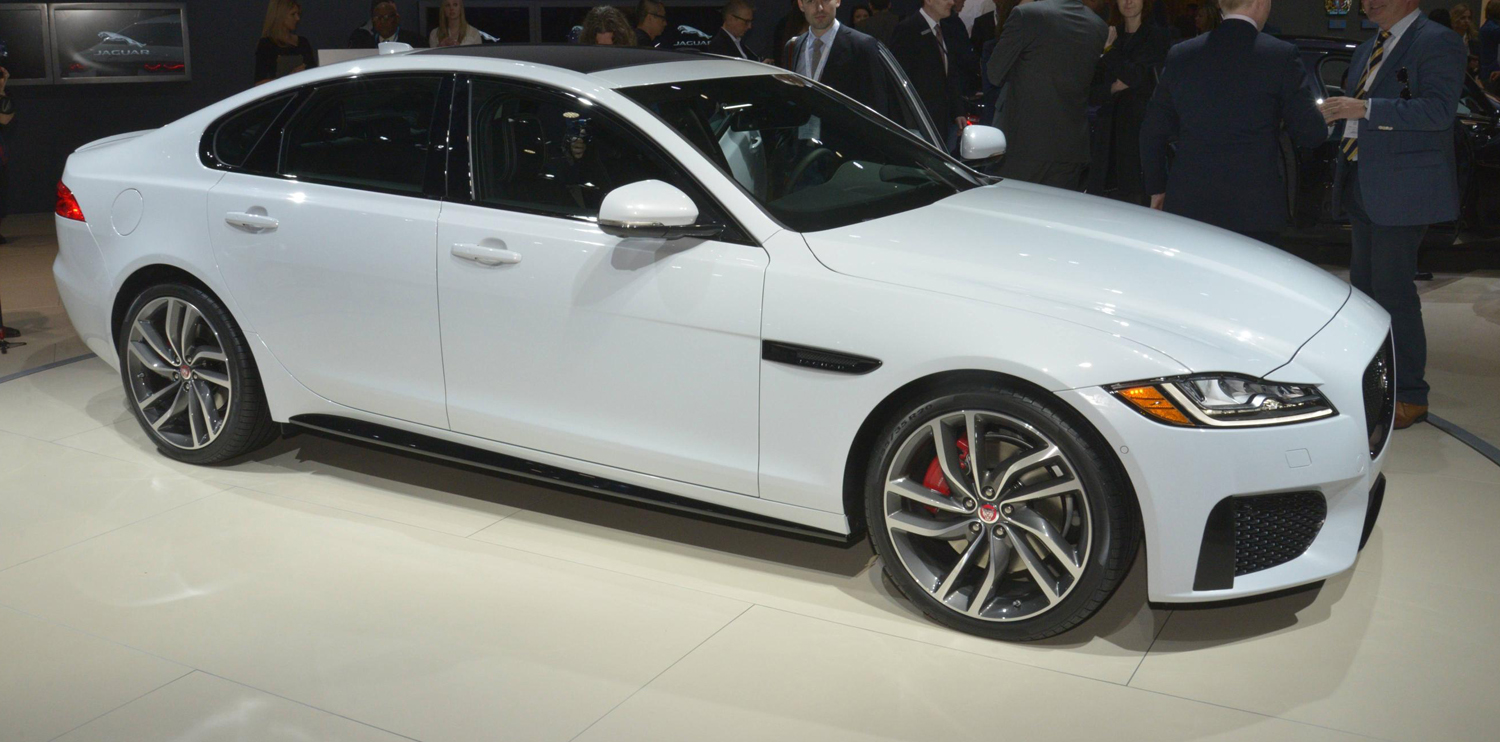
CHASSIS
The all-new Jaguar XF exceeds expectations of how a sedan should ride, handle and steer. Comfort and refinement have been taken to a higher level and combined with excellent agility and responsiveness. The light yet exceptionally stiff body with its combination of aluminum and advanced high-strength steels delivers a near-50:50 weight distribution.
Double-wishbone front and Integral Link rear suspension systems provide the inherently high levels of stiffness needed for agile handling and steering precision with the compliance essential for first-class comfort and refinement. Advanced damper technologies – both passive and continuously-variable – improve ride quality and extend the breadth of dynamic capability of the XF.
“The all-new XF has to deliver both driver reward through agility and immediacy of response when it’s called for, and yet great ride composure and comfort too. The light and rigid aluminum intensive architecture of the all-new XF is a key enabler for us delivering those attributes, as it provides an optimal basis for finely tuning the ride and handling characteristics of the car. The result is that the new XF is as satisfying to drive quickly, as it is comfortable to be driven in.” – Mike Cross, Chief Engineer of Vehicle Integrity, Jaguar
With many components made entirely from lightweight aluminum, the double-wishbone front suspension of the XF is modeled closely to that of the Jaguar F-TYPE. Its high camber stiffness means that the tires are able to generate lateral force immediately – which translates to sharper and more immediate turn-in. And the high roll camber gain means that the tire’s contact patch is maintained, generating more grip and delivering better feel.
Other refinements include lighter springs made from narrower-gauge steel and low-friction, PTFE-lined bushes for the tubular anti-roll bar.
Integral Link Rear Suspension
The optimum balance of ride and handling requires lateral and longitudinal stiffness to be tuned independently. Integral Link suspension enables the all-new XF to realize exceptional levels of comfort and handling. Bushes soft in recession allow the wheels to move rearwards and upwards upon impact, providing excellent energy absorption characteristics.
At the same time, camber stiffness can be increased, delivering greater responsiveness. Greater caster stiffness can also be achieved, for greater stability under braking.
Electric Power-Assisted Steering2
Steering response and on-center feel are among the most important attributes which define the Jaguar dynamic driving DNA. One of the key enablers to this is the tuning potential of electric power-assisted steering (EPAS). From filters which damp unwanted disturbances caused by road surface irregularities to algorithms which compensate for changes in ambient temperature – EPAS has a lot to offer.
Incorporating all of the learning from the F-TYPE and XE, the advantages of EPAS have been fully exploited, giving the all-new XF a more connected feel with an intuitive, linear response.
Passive Damping and Adaptive Dynamics
Making the body of the all-new XF lighter and stiffer delivers inherent benefits in terms of ride control, but Jaguar dynamics engineers looked closely at other fundamental improvements that could be made. One of the most effective was the integration of next-generation passive damper technology to enhance comfort.
The new passive dampers enable frequency-dependent damping – the ability to vary damping force not only with the velocity that the damper piston moves at, but also as a function of its frequency.
An extra valve in the piston provides an additional bypass. At road speeds typical of town driving, the valve is open, allowing some fluid to flow through it instead of the main valve in the piston. This reduces the damping force and makes the ride smoother and suppler. With increasing speed the valve closes, forcing all of the fluid to pass through the piston: damping force increases and the ride becomes firmer.
The Jaguar Adaptive Dynamics system2 has also evolved. Still monitoring body movement 100 times a second and wheel movement 500 times a second, the control algorithms for the adaptive dampers are now more advanced – further enhancing low-speed ride comfort as well improving handling and agility at higher speeds 3.
Configurable Dynamics2
First developed for the F-TYPE, Configurable Dynamics takes the duality of character of the XF to the next level. The system allows the driver to individually tailor the throttle mapping, transmission shift strategy, steering feel and Adaptive Dynamics settings using the touchscreen. Configurable dynamics is offered in conjunction with Adaptive Dynamics.
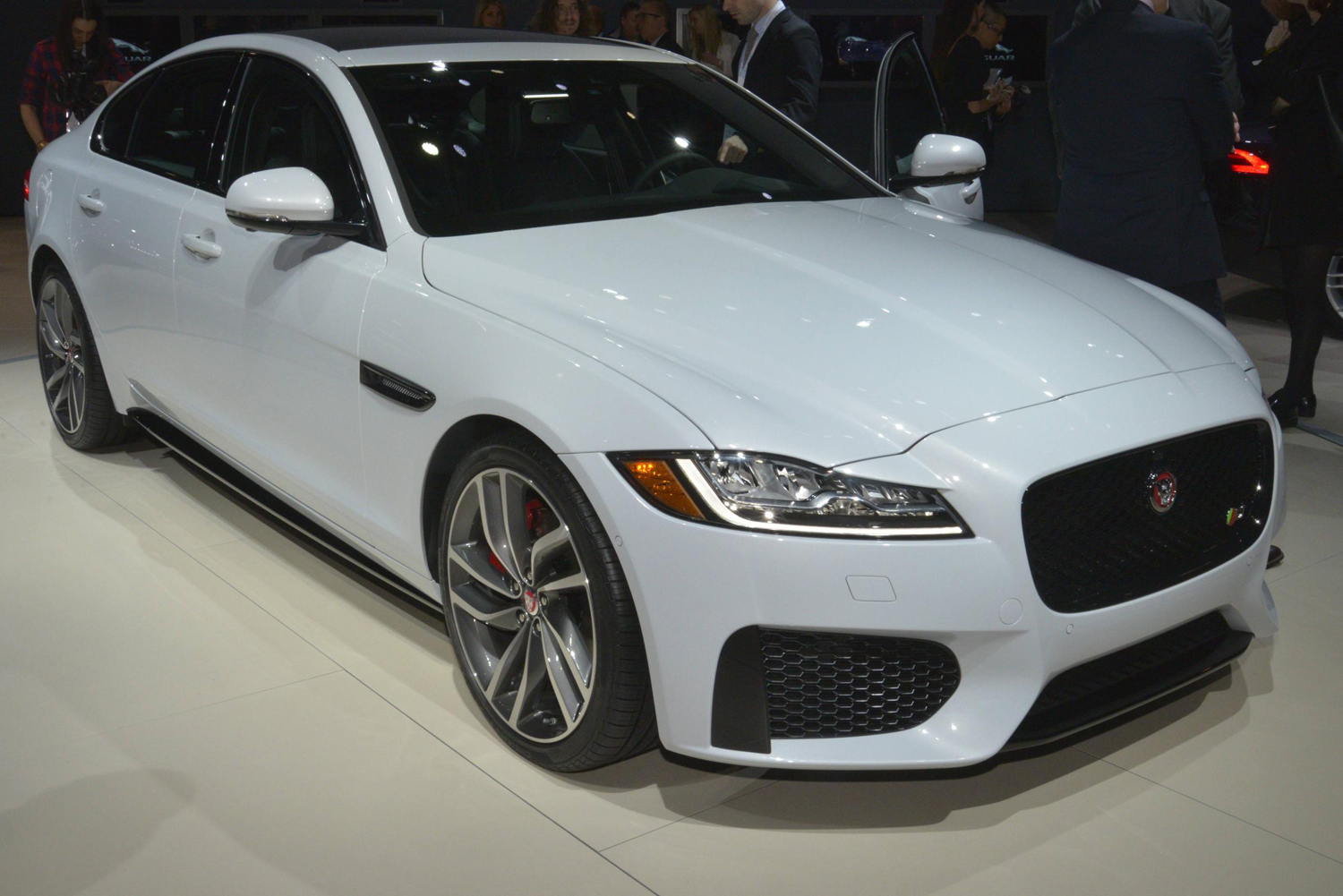
POWERTRAIN
Enthusiasts demanding the most involving driving experience now have the choice of the Jaguar free-revving 3.0-liter supercharged V6 engine in 340hp and 380hp ratings -equipped with either rear- or all-wheel drive (AWD).
Shared with the F-TYPE, these engines combine supercharging with direct-injection and variable intake and exhaust valve timing to deliver exceptional throttle response, linear power delivery and a unique soundtrack.
A single balancer shaft enhances smooth-running and refinement, while a carefully-tuned symposer feeds some of the supercharged V6’s induction sound back into the cabin to make exploiting the performance potential even more exhilarating.
This is the first time the 380hp version has been used in a Jaguar sedan and is reserved for the all-new XF S. Matched to an eight-speed automatic transmission, this model is capable of covering the 0-60mph sprint in 5.1 seconds on its way to an electronically-limited maximum speed of 155mph 3.
Optimized eight-speed automatic transmissions
The all-new Jaguar XF is available with one of two specifically-optimized eight-speed automatic ZF® transmissions. AWD engines are paired with the familiar 8HP70 transmission, while rear-wheel drive derivatives are matched to the lighter, more compact 8HP45. Combined with the unique Jaguar rotary gear shift controller and paddle shifters, these transmissions offer an exceptional driving experience, blending smooth launch behavior with seamless shifting.
The transmission module monitors driving style and adapts its shift pattern to suit. The ECU is also networked to the JaguarDrive Control™, offering quicker shifts and more dynamic kickdown in Dynamic mode, and earlier up-shifts in Eco mode.
Torque Vectoring by Braking2
Another technology proven first on F-TYPE and now standard on the all-new XF is Torque Vectoring by Braking. On corner entry, lightly braking the inner wheels individually can mitigate understeer and help the driver to take the ideal line. Intervention is subtle and virtually transparent to the driver, but the increased agility is felt immediately.
All-Wheel Drive with Intelligent Driveline Dynamics2
With the option of AWD, the all-new XF builds on the success of its predecessor with a next-generation torque on demand system and Intelligent Driveline Dynamics (IDD). To maximize the system’s potential, IDD is networked to the Torque Vectoring by Braking system and the Dynamic Stability Control.
IDD is designed to preserve Jaguar dynamics DNA while maximizing the performance and handling benefits of the additional traction, especially in adverse conditions or on poor road surfaces. Primarily a rear-wheel drive sports sedan, the all-new XF also satisfies growing worldwide demand for AWD vehicles.
Integrated into the eight-speed automatic transmission, AWD is available with the 340hp and 380hp supercharged V6 engines. In normal driving, all of the torque is sent to the rear axle. But when required, a multi-plate wet clutch diverts torque to the front axle via a chain drive in the transfer case.
How much torque is transferred – and when – is controlled by the IDD module, which is integrated into the transfer case. Using sensor data such as yaw rate, steering wheel angle and lateral acceleration, algorithms within the IDD controller continuously estimate road surface friction, and how much of the available grip is being exploited at each tire contact patch.
If IDD predicts that the rear tires are approaching the traction limit, torque is seamlessly transferred to the front axle. IDD also functions reactively, and can vary the front-rear torque split to mitigate oversteer in fast corners through yaw damping.
Adaptive Surface Response2
Adding to the AWD capability of the all-new XF is Adaptive Surface Response (AdSR) which is designed to determine what kind of surface the car is driving on – normal roads, wet or gravel roads, or snow and ice – and modify the maps for the steering, throttle, transmission and stability control systems according to the conditions.
AdSR, standard on vehicles equipped with both AWD and Adaptive Dynamics, replaces JaguarDrive Control’s Winter mode. AdSR functions throughout the vehicle’s entire speed range.
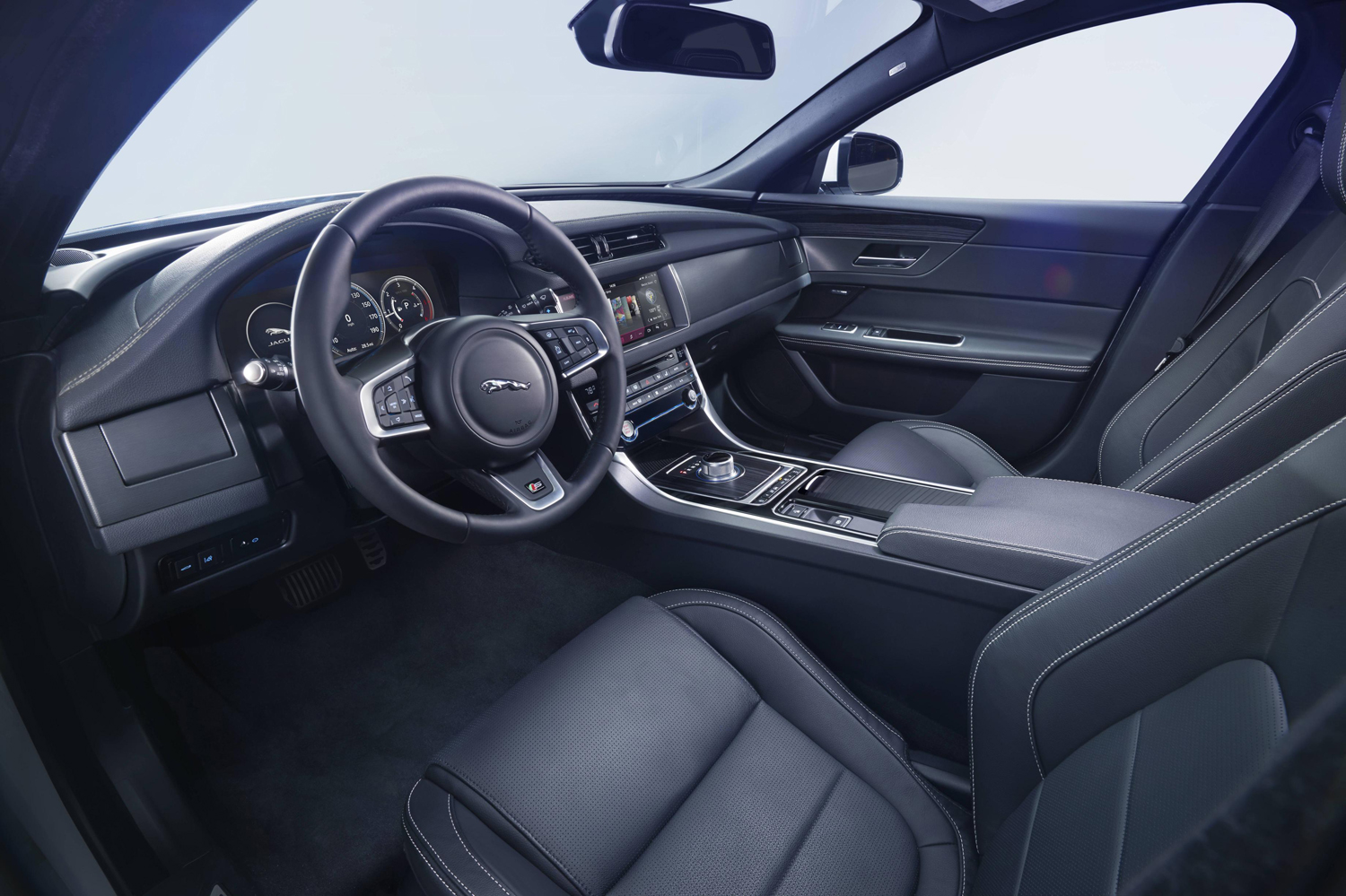
INFOTAINMENT AND CONNECTIVITY
Jaguar InControl® Touch™1
The all-new XF features two available infotainment systems. The standard system is InControl Touch and is based around an 8-inch capacitive touchscreen featuring the new Jaguar user interface. Designed to be simple and intuitive to use, the contemporary graphics are crisp and clear. The touchscreen supports gestures familiar to smartphone and tablet users such as ‘swipe’ to perform actions and ‘drag’ to scroll across maps.
For customers who prefer voice control, enhanced speech recognition enables the driver to enter destinations into the navigation system or call contacts directly.
Text-to-voice technology helps to reduce driver distraction by reading out incoming SMS messages. When the vehicle is stationary the driver can use the touchscreen to compose messages or, for convenience, select one of the stored response templates.
Planning journeys through the available navigation system is quicker and easier thanks to smart data entry and faster route calculation. Map data stored on a SD card is rendered in high quality 2D and 3D images.Turn-by-turn instructions can also be shown in the optional Heads-Up Display 2, enabling the driver to keep their eyes on the road.
InControl Touch Pro™1
The all-new Jaguar XF is the first model to feature the equally new InControl Touch Pro™ infotainment system. At the heart of InControl Touch Pro is a 10.2-inch capacitive touchscreen. There are no buttons on either side, instead, all the functionality has been neatly integrated into the bottom section of the touchscreen.
“Jaguar InControl Touch Pro is the most sophisticated infotainment system we’ve ever developed and uses a quad-core processor, solid-state driver and Ethernet to deliver exceptional performance. The 10.2-inch touchscreen and features such as our latest navigation that can learn your commute make every journey in the all-new XF more rewarding.” – Ian Hoban, Vehicle Line Director, Jaguar XF
Like a smartphone, the home screen can be customized; wallpaper can be set to any image, and widgets can be added to provide shortcuts to favorite features. It’s even possible to add extra home screens. The touchscreen also features ‘pinch to zoom’ gestures familiar to all smartphone users.
Map data for InControl Touch Pro™ is stored on a solid-state drive (SSD) that can be accessed in a fraction of the time taken with conventional hard drive systems. Dead-reckoning functionality, which interprets vehicle data up to 40 times a second, can accurately position the vehicle even when GPS signals can no longer be received.
Utilizing a data connection enables even greater functionality and location-based features and information. The all-new XF offers door-to-door route planning and guidance incorporating public transport options, Commute Mode which learns your daily drive so that it can automatically offer alternative routes to avoid congestion using historical and real-time traffic information, and Approach Mode which shows a 360° interactive view of your destination when you’re approximately 650ft away.
On-board, Gracenote album art stored on the SSD drive enrich the music listening experience while functions such as ‘Play more like this’ make it simpler to access all of your favorite tracks. Adding to the experience, InControl Touch Pro™ includes a 17-speaker, 825W digital surround sound system developed with renowned British audio experts Meridian™. The system benefits from the Meridian Trifield™ and Audyssey’s MultEQ XT technologies which ensure optimum sound reproduction with benchmark low levels of distortion.
The modules which make up InControl Touch Pro™ are connected using Ethernet. With a bandwidth of up to 1Gbit/ second, Ethernet can handle massive amounts of data, enabling very high infotainment system performance.
Together with a powerful quad-core processor and the solid-state drive, Ethernet allows InControl Touch Pro™ to deliver smooth graphics and extremely fast response times. These two technologies also ensure that the system’s capability can be further enhanced in the future.
Jaguar InControl® Features
Dialing-in to a conference call, booking a hotel room or just catching up with the news, with the optional Jaguar InControl® Apps™ the all-new Jaguar XF ensures that drivers can seamlessly connect Apple® and Android™ smartphones to the vehicle. Via a USB cable and the dedicated port in the center console, InControl Apps™ provides access to compatible apps on the device using the vehicle’s touchscreen1.
Also compatible with the all-new XF is the new Jaguar InControl Remote™, which enables customers to interact with the vehicle using a smartphone. Through the app vehicle owners can bring the cabin to a pre-set temperate by remotely starting the engine, and can check key vehicle data such as fuel tank fill level and door lock status. The app also enables the driver to remotely lock or unlock the car and receive alerts if the alarm sounds, with the option to reset it. A beep and flash feature can help drivers find the vehicle if they’ve forgotten where it was parked or provides a map to lead them to it.
Should the vehicle be involved in a collision severe enough to trigger the airbags, InControl Protect™ is designed to automatically notify emergency services and provide GPS location of the vehicle. Occupants can also trigger an emergency call manually by pressing a button on the upper console. InControl Protect™ also features a stolen vehicle locator with the service provider using vehicle location obtained via GPS and vehicle details information to locate the vehicle to work with the law enforcement agencies to recover the car as quickly as possible.
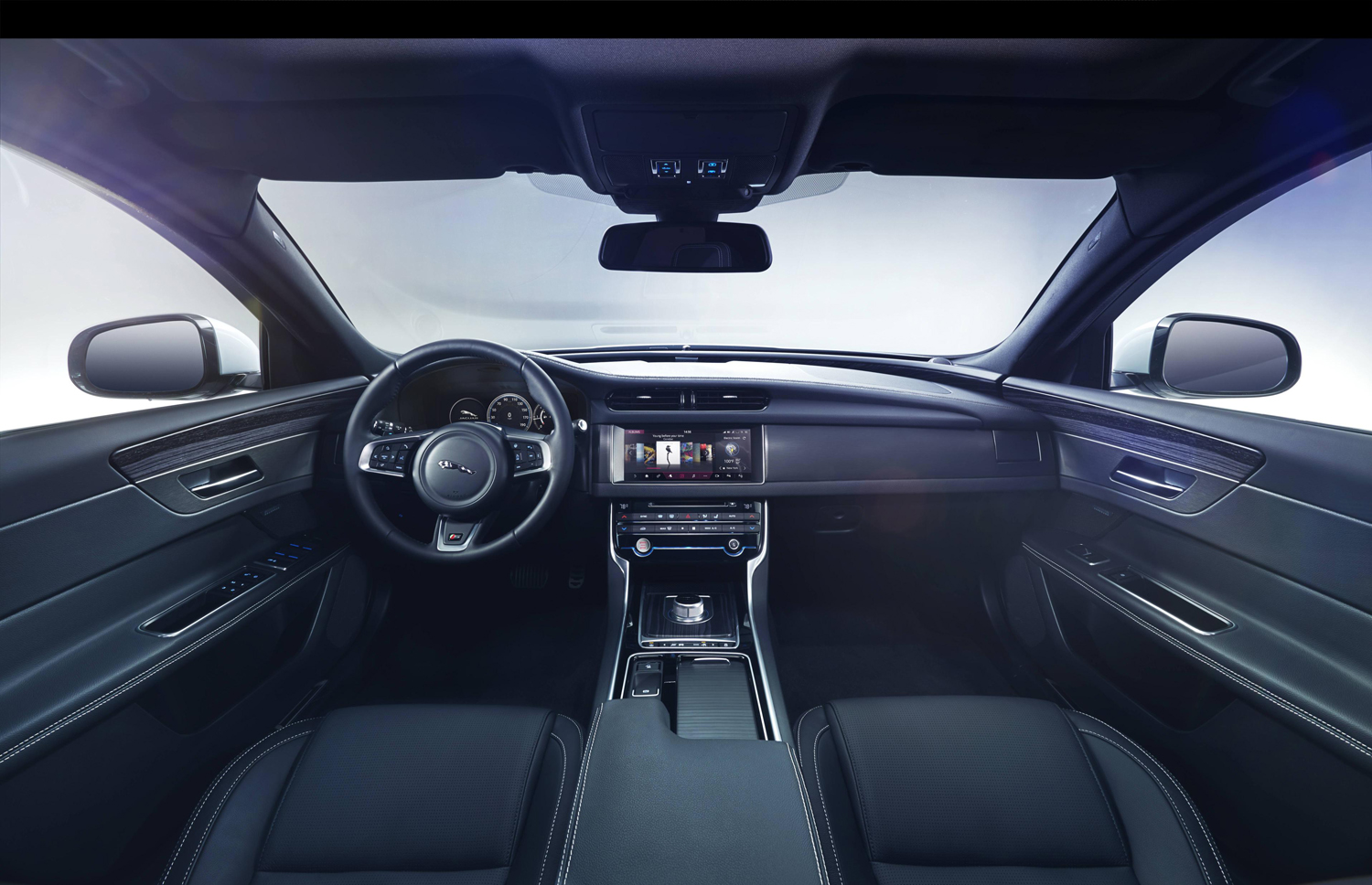
ADVANCED DRIVER ASSISTANCE TECHNOLOGY
All-Surface Progress Control2
Pulling away on low-friction surfaces such as snow, ice or wet grass can be challenging; which is why the all-new XF features the revolutionary Jaguar Land Rover All-Surface Progress Control (ASPC) system.
Leveraging the knowledge built up over decades of Jaguar Land Rover experience in off-road technologies, ASPC delivers a step-change in capability because there’s no driver input on the pedals: the driver just has to steer.
ASPC works like a low-speed cruise control and can operate between 2 mph (3.6km/h) and 19mph (30km/h). The system is activated by pressing a button on the center console and then the driver uses the cruise control switches on the steering wheel to set the maximum speed.
What makes ASPC so effective is that it doesn’t just provide fine control of the throttle: it also uses the brakes in opposition to the throttle so that from standstill, only very low engine torque is applied to the driven wheels. This capability is designed to ensure smooth progress with little or no wheel spin.
ASPC is standard on the entire XF model range.
Forward-facing stereo camera
Located in front of the rear-view mirror, the available forward-facing stereo camera generates a 3D view of the road ahead. The information is interpreted by image processing software and the output used by a wide range of advanced driver assistance systems.
One of the most important is the Autonomous Emergency Braking (AEB) system 2. If the module determines that a collision with a vehicle ahead is likely, the brake system is pre-charged and the driver given audible and visual warnings. If no avoiding action is taken and the collision deemed to be imminent, the system is designed to initiate full braking to avoid it or mitigate the effects.
The stereo camera also supports the Lane Departure Warning (LDW) and Lane-Keeping Assist (LKA) systems2 available on the Jaguar XF. By monitoring the vehicle’s position relative to lane markings, LDW is designed to notify the driver if they begin to drift out of lane by providing visual warning in the instrument panel and a haptic warning through the steering wheel rim. If the driver drifts too close to the edge of the lane, the LKA system can guide the driver towards the center of the lane by applying a small amount of counter-steering. The amount of torque applied to the steering wheel is slight and can be easily over-ridden by the driver at any time.
Available on the all-new XF, the Driver Drowsing Monitoring (DDM) system2 is designed evaluate patterns of driver inactivity, such as little or no steering, pedal or instrument panel activity followed by sudden or excessive inputs, and provide multistage visual and audible warnings when driver drowsiness is noticed.
The Traffic Sign Recognition (TSR) system2 relies on the stereo camera to keep the driver informed of speed limits – including temporary limits which apply during road work and variable limits on highways. Camera data is cross-referenced against GPS data to ensure accuracy. If the driver selects the over-speed warning function, the ring around the sign graphic flashes whenever the limit is exceeded.
Intelligent Speed Limiter2
To assist drivers in areas where speed limits change often, Jaguar has developed an Intelligent Speed Limiter (ISL) which uses the TSR system data to monitor changes in the speed limit and automatically increase or decrease the vehicle’s speed to match.
If the TSR system recognizes a higher speed limit ahead, the system is designed to notify the driver and the vehicle can accelerate smoothly up to the new limit. If the speed limit is lower, the vehicle can be slowed down accordingly. If the driver presses the Resume button, the rate of acceleration or deceleration will increase.
Laser Heads-Up Display2
The all-new XF is the latest Jaguar sedan to feature a laser Heads-Up Display (HUD). Projecting key information such as vehicle speed, gear shift indication and navigation instructions onto the windshield, this system is designed to help the driver keep their eyes on the road.
The color images are exceptionally sharp and are adjustable both in height and in brightness, making it easy to find the ideal setting. The HUD may also be switched off if desired.
Laser technology offers several advantages over conventional TFT systems. The images it generates offer superior color saturation and higher contrast, so they’re more resistant to ‘washout’ in bright sunlight. And the system is not only more compact, but it’s almost a third lighter.
Adaptive Cruise Control with Queue Assist2
The Adaptive Cruise Control (ACC) system familiar from the previous XF has been enhanced with a function designed to take even more of the effort and monotony out of driving in heavy traffic. Using a long-range 77GHz scanning radar, the system is designed to maintain a safe distance from the vehicle in front, all the way down to a standstill. Queue Assist then enables the all-new XF to track the vehicle in front as the traffic starts moving again.
Closing Vehicle Sensing and Reverse Traffic Detection2
Closing Vehicle Sensing and Reverse Traffic Detection are designed to monitor the area behind the vehicle. Medium-range sensors will alert the driver to the presence of vehicles approaching fast from behind once they’ve closed to within 229.7-ft (70 meters). As the vehicles approach the blind spot, a flashing icon appears in the mirror as a warning. Once the vehicle enters the blind spot, the icon is shown as a solid.
At slower speeds, such when reversing out of a space in a busy parking area, the same radar sensors can also warn drivers of approaching vehicles which may be hidden from view or are outside the driver’s peripheral vision.
Park Assist
The all-new XF features semi-automated park assist functions for both perpendicular and parallel parking. Ultrasonic sensors measure the space and, if it’s suitable, will enable the car to steer itself into position; the driver simply has to operate the accelerator and the brakes. In the case of parallel parking, the system can also steer the vehicle out again.
Complementing this feature is the surround camera system. Five cameras combine to give a 360° view of the area around the car, including a plan view, to make maneuvering easier and safer.
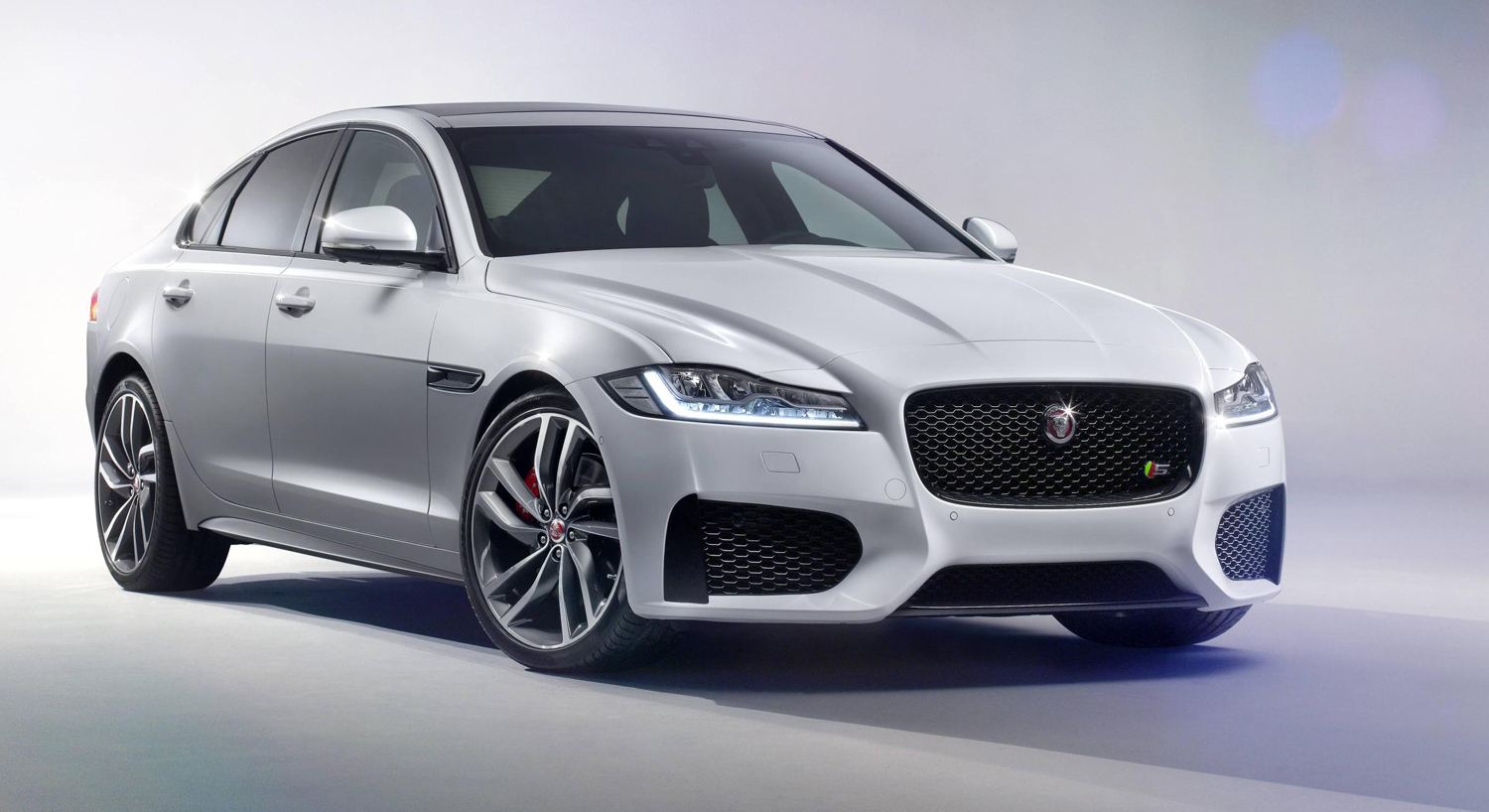
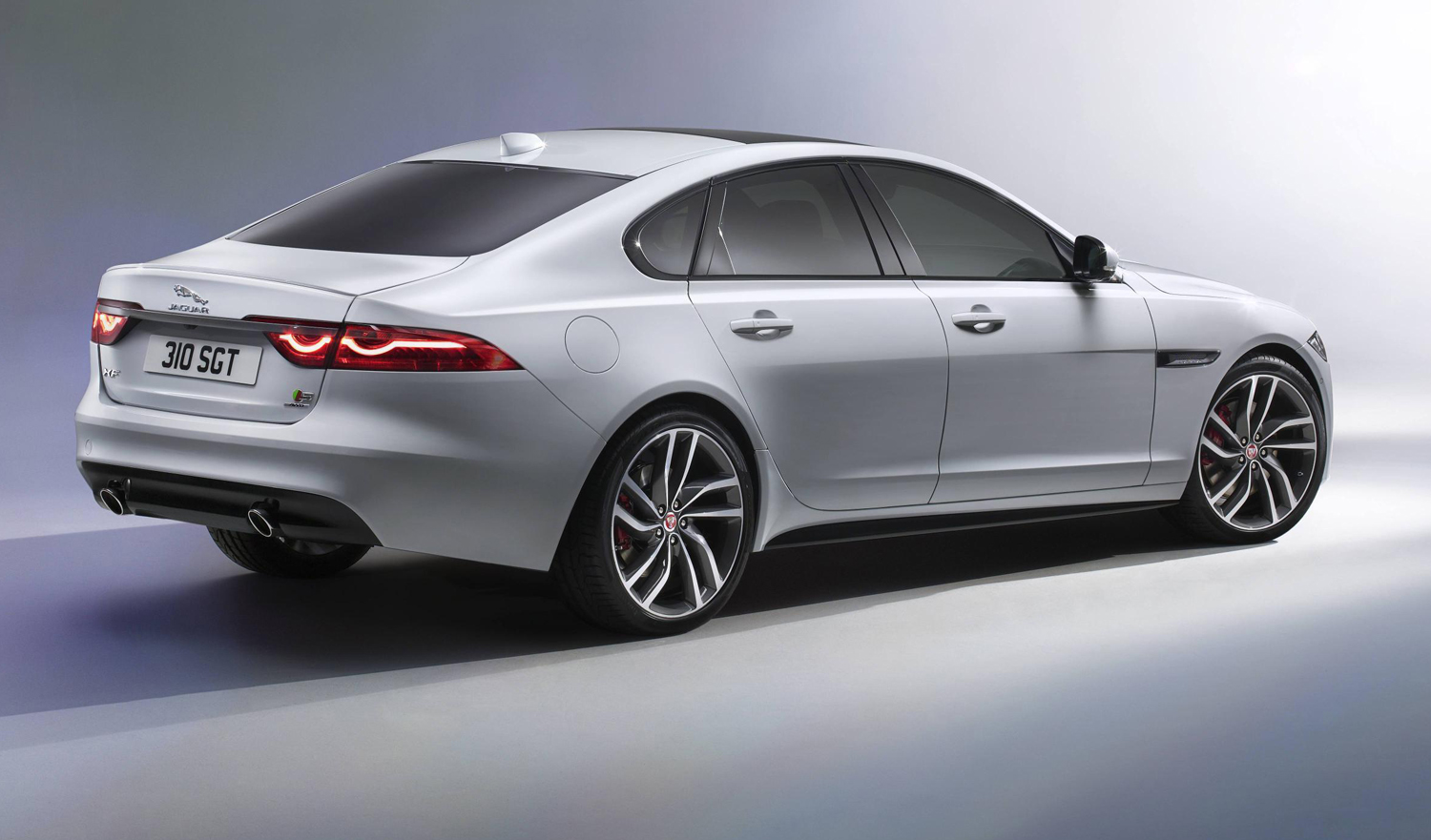
TECHNICAL SPECIFICATIONS
| 340-hp Supercharged 3.0L V6 | 380-hp Supercharged 3.0L V6 | |
| ENGINE & TRANSMISSION | ||
| Engine capacity | 2,995cc | 2,995cc |
| Cylinders | 6 in-vee | 6 in-vee |
| Valves per cylinder | 4; DOHC, variable inlet and exhaust cam timing | 4; DOHC, variable inlet and exhaust cam timing |
| Bore x stroke | 84.5 x 89.0 mm | 84.5 x 89.0 mm |
| Compression ratio | 10.5:1 | 10.5:1 |
| Fuel injection | 150bar direct injection | 150bar direct injection |
| Boosting system | Twin-Vortex supercharger | Twin-Vortex supercharger |
| Power | 340hp @ 6,500rpm | 380hp @ 6,500rpm |
| Torque | 332 lb. ft. (450Nm) @ 4,500rpm | 332 lb. ft. (450Nm) @ 4,500rpm |
| Transmission | RWD: ZF 8HP45 8-speed autoAWD: ZF 8HP70 8-speed auto | RWD: ZF 8HP45 8-speed autoAWD: ZF 8HP70 8-speed auto |
| Gear ratios (:1) | ||
| 1st | 4.714 | 4.714 |
| 2nd | 3.143 | 3.143 |
| 3rd | 2.106 | 2.106 |
| 4th | 1.667 | 1.667 |
| 5th | 1.285 | 1.285 |
| 6th | 1.000 | 1.000 |
| 7th | 0.839 | 0.839 |
| 8th | 0.667 | 0.667 |
| Reverse | 3.317 | 3.317 |
| Final Drive | 3.23 | 3.23 |
| CHASSIS | ||
| Front suspension | Double wishbone | Double wishbone |
| Rear suspension | Integral Link | Integral Link |
| Steering | Rack-and-pinion; electromechanical power-assisted | Rack-and-pinion; electromechanical power-assisted |
| DIMENSIONS | ||
| Length | 195in (4,954mm) | 195in (4,954mm) |
| Width inc./excl. mirrors | 82.3in (2,091mm)/74in (1,880mm) | 82.3in (2,091mm)/74in (1,880mm) |
| Height | 57.4in (1,457mm) | 57.4in (1,457mm) |
| Wheelbase | 116.5in (2,960mm) | 116.5in (2,960mm) |
| Track front/ rear | 63.2in (1,605mm)/62.8in (1,594mm) | 63.2in (1,605mm)/62.8in (1,594mm) |
| Curb weight | RWD: From 3,770lbs (1,710kg)AWD: From 3,880 (1,760kg) | RWD: From 3,770lbs (1,710kg)AWD: From 3,880 (1,760kg) |
| Trunk volume | 142.7gal (540 liters) | 142.7gal (540 liters) |
| Fuel tank; usable | 19.5gal (74 liters) | 19.5gal (74 liters) |
| PERFORMANCE | ||
| 0-60mph3 | RWD: 5.2 secAWD: 5.1 sec | RWD: 5.1 secAWD: 5.0 sec |
| 0-100km/h | 5.3 sec | 5.3 sec |
| Top speed | 155 mph (250 km/h) | 155 mph (250 km/h) |
1 Do not use Jaguar InControl® features under conditions that will affect your safety or the safety of others. Driving while distracted can result in loss of vehicle control.
2 These features are not a substitute for driving safely with due care and attention and will not function under all circumstances, speeds, weather and road conditions, etc. Driver should not assume that these features will correct errors of judgment in driving. Please consult the owner’s manual or your local authorized Jaguar Retailer for more details.
3 Always follow local speed limits.
